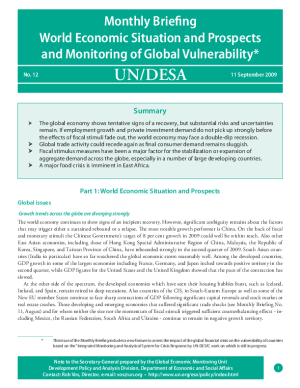September 2009
Summary:?
- The global economy shows tentative signs of a recovery, but substantial risks and uncertainties?remain. If employment growth and private investment demand do not pick up strongly before?the effects of fiscal stimuli fade out, the world economy may face a double-dip recession.
- Global trade activity could recede again as final consumer demand remains sluggish.
- Fiscal stimulus measures have been a major factor for the stabilization or expansion of aggregate demand across the globe, especially in a number of large developing countries.
- A major food crisis is imminent in East Africa.
The world economy continues to show signs of an incipient recovery. However, significant ambiguity remains about the factors?that may trigger either a sustained rebound or a relapse. The most notable growth performer is China. On the back of fiscal
and monetary stimuli the Chinese Government?s target of 8 per cent growth in 2009 could well be within reach. Also other
East Asian economies, including those of Hong Kong Special Administrative Region of China, Malaysia, the Republic of
Korea, Singapore, and Taiwan Province of China, have rebounded strongly in the second quarter of 2009. South Asian coun-
tries (India in particular) have so far weathered the global economic storm reasonably well. Among the developed countries,
GDP growth in some of the largest economies including France, Germany, and Japan inched towards positive territory in the
second quarter, while GDP figures for the United States and the United Kingdom showed that the pace of the contraction has
slowed.
?
At the other side of the spectrum, the developed economies which have seen their housing bubbles burst, such as Iceland,?Ireland, and Spain, remain mired in deep recessions. Also countries of the CIS, in South-Eastern Europe as well as some of the new EU member States continue to face sharp contractions of GDP following significant capital reversals and stock market or?real estate crashes.
?
Download the World Economic Situation and Prospects Monthly Briefing No. 12
 Welcome to the United Nations
Welcome to the United Nations
